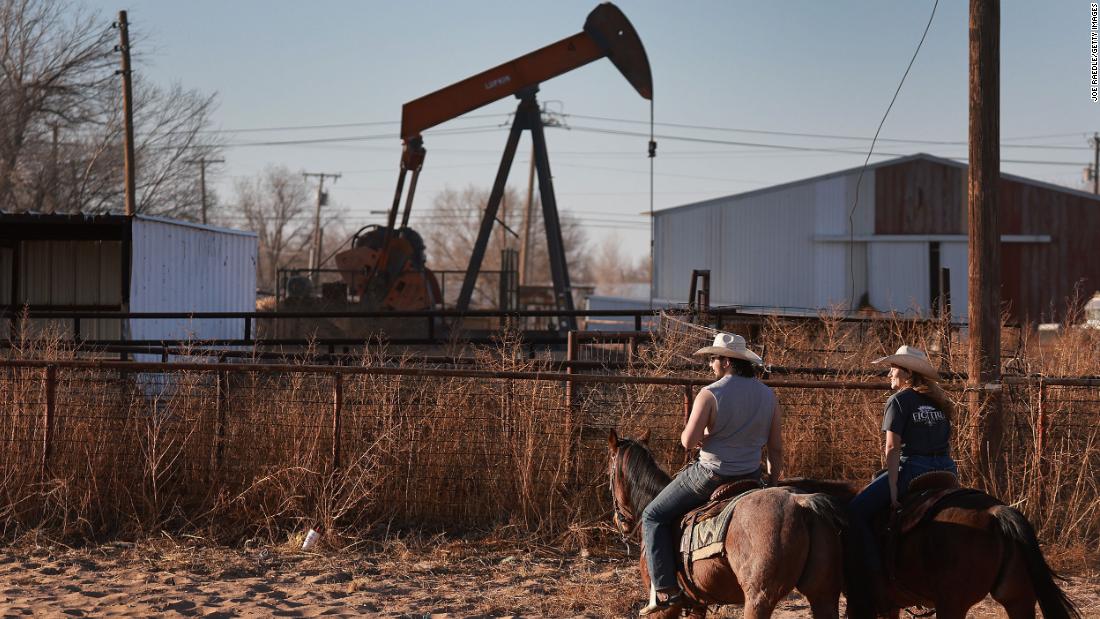Gas prices are high. Oil CEOs reveal why they’re not drilling more
For years, the boom-to-bust oil industry spent lavishly to fund all-out production growth. US oil output skyrocketed, keeping prices low. Yet sustaining profits proved elusive. Hundreds of oil companies went bankrupt during multiple oil price crashes, leading investors to demand more restraint from energy CEOs.
Today, oil companies are under enormous pressure from Wall Street to return cash to shareholders through dividends and buybacks, instead of investing in badly needed supply.
US output is down even as prices skyrocket
Prices, on the other hand, have surged. US crude oil closed at $114.93 a barrel Wednesday, up 88% from the end of 2019.
Current prices are well above the $56 per barrel average that oil companies told the Dallas Fed they need to profitably drill. Larger companies said they need per barrel prices of just $49 to turn a profit.
Yet oil executives and investors don’t want to add so much supply that it causes another glut that crashes prices. And shareholders want companies to return excess profits in the form of dividends and buybacks, not reinvest them in increasing production.
“Investors dumped huge funds into shale drilling only to discover that when oil prices dropped, very little value existed at the end of the day,” the executive said.
Only 6% blame government regulation
Following Russia’s invasion of Ukraine, the US price of regular gasoline hit a record high of $4.33 a gallon.
Although environmental policies are often blamed for high energy costs, oil executives do not seem to view them as the central factor here.
Just 6% of executives polled by the Dallas Fed pointed to government regulations as the primary reason publicly-traded oil companies are restraining production growth.
Another 11% pointed to environmental, social and governance (ESG) issues. The ESG movement has led many investors to shy away from fossil fuel companies in favor of clean energy ones.
About 15% of executives said “other” factors were to blame, including personnel shortages and supply-chain problems.
‘Vilification’ of the oil industry
Still, multiple executives surveyed expressed significant concern about regulations and rhetoric on the industry coming from the federal government as well as individual states such as Colorado.
“The message from the White House, Capitol Hill and Wall Street has been that oil and gas is a dying industry and one that needs to be abandoned,” one survey respondent said. That executive pointed to “serious workforce issues” that are being driven in part by the “vilification” of the oil-and-gas industry.
“Regulation is significantly hurting and hampering US energy production,” another executive said.
For consumers worried about near-record gasoline prices, the good news is that more supply is coming.
The business activity index in the Dallas Fed survey jumped in the first quarter to the highest level in its six-year history. That gain was driven by a sharp increase in the oil production index.
The bad news is that Big Oil companies are signaling just a modest increase in supply.
Among large oil companies, the median production growth rate between the fourth quarter of last year and first quarter of this year was 6%. Small firms, many of which are not publicly traded, expect much faster production growth of 15%.
If US oil companies and OPEC fail to ramp up output, analysts have warned that energy prices will likely stay painfully high.
One oil executive in the Dallas Fed survey said the United States needs to raise production by about two million barrels per day in 2023 to balance global supply and demand.
“It is looking unlikely that this will happen,” the executive said, “which will result in sustained higher energy prices until the American consumer is pushed into recession.”
For all the latest world News Click Here

